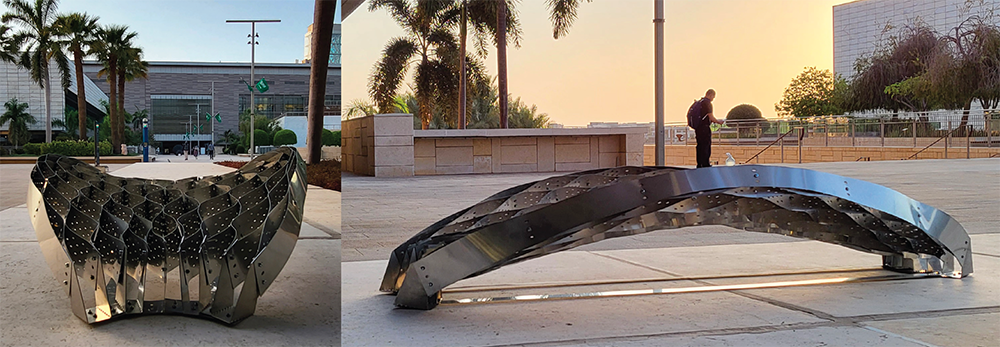Simulation and Fabrication of Elastic Deployable Stripe Structures
Abstract
Deployable structures have many applications in architecture, from kinetic pavilions to temporary structures, to retractable rooftops. There are various advantages to building deployable elements in a factory, and then deploying them on site. It is simpler to join stripes in flat arrangements than to put them together in three dimensions. This study focuses on a novel approach for creating and simulating systems of elastic stripes and how they can be utilized to build 3d-surfaces. The goal is to find the correct 2D stripes geometry that when deployed corresponds to a given 3D designed surface. Deployment simulation is essential to the design phase, and it is believes that by designing, simulating, and re-using data from already tested physical models, kinetic design methodological framework would naturally transition from a Design-Fabrication-Simulation workflow into a Design-Simulation-Fabrication one. (Raviv et al. 2014). In order to find the stripes deployment and its proximity to the final 3d surface, three experiments are examined ere: Starting from a simple case, in order to get a negative Gaussian curvature (Figure 1, Top) and observe the transformation and distortion of the flat faces, a hexagonal flat model has been vertically extruded and anchored in two points. Then, investigating further deploying techniques for negative curvature surfaces, a 2D linear set of equal stripes is deployed evenly by adding a locker stripe on its ends (Figure 2, Bottom). From the prototype and the simulation deployment the distortion produced a negative Gaussian curvature. A more complex example of curved stripes, using a locker stripe at the start and connecting between them, a group of four curved deployable stripes were distorted and joined to create four arches while maintaining their opening state (Figure 3, Right). The same distortion was seen in both the arches simulation and the prototype.
Keywords
Parametric Cladding, Building Simulation.
Bibliography
- Mhatre, S., Boatti, E., Melancon, D., Zareei, A., Dupont, M., Bechthold, M., & Bertoldi, K. (2021). Deployable Structures Based on Buckling of Curved Beams Upon a Rotational Input. Advanced Functional Materials, 31(35), 1–7.
- Soleimani, H., Goudarzi, T., & Aghdam, M. M. (2021). Advanced structural modeling of a fold in Origami/Kirigami inspired structures. Thin-Walled Structures, 161(February), 107406.
- Sageman-Furnas, A. O., Chern, A., Ben-Chen, M., & Vaxman, A. (2019). Chebyshev nets from commuting PolyVector fields. ACM Transactions on Graphics, 38(6).
- Callens, S. J. P., & Zadpoor, A. A. (2018). From flat sheets to curved geometries: Origami and kirigami approaches. Materials Today, 21(3), 241–264.
- Tang, Y., Li, Y., Hong, Y., Yang, S., & Yin, J. (2019). Programmable active kirigami metasheets with more freedom of actuation. Proceedings of the National Academy of Sciences of the United States of America, 116(52), 26407–26413.
- Pellis, D., Wang, H., Kilian, M., Rist, F., Pottmann, H., & Müller, C. (2020). Principal symmetric meshes. ACM Transactions on Graphics, 39(4), 1–17.
- Magna, R. La, & Knippers, J. (2018). Humanizing Digital Reality. Humanizing Digital Reality, December 2017.
